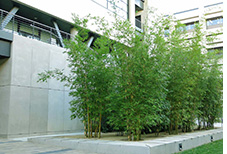


The interior circle was about 25 feet in diameter and the grove of bamboo completely filled it. My favorite example was a grove of bamboo with a concrete driveway that circled the bamboo. I often see groves of bamboo in urban areas surrounded by pavement that has been there for years without spreading. Usually bamboo won't cross a paved road as the soil is too compacted. No way could I kick them over so now, a couple years later, there are half a dozen giant canes outside the circle. Both were the largest shoots my grove had produced, 5 to 6 inches in diameter. At one point a Moso rhizome crossed the dirt road and I discovered it when a couple of new shoots came up on the other side the following spring. The mature grove of Moso can send rhizomes out well over 30 feet in a season. If trucks or equipment are being driven over the road when new rhizomes are growing, they are usually crushed at that point. I have a large grove of giant Moso bamboo surrounded by a tractor trail or dirt road.

Step 4 Dirt roadsĮven a dirt road that is well traveled will often form a barrier. I've seen this method used, but it's not my favorite and not the most effective. You will then need to push a shovel down into the trench, all the way around the bamboo each fall to cut any rhizomes. A variation on this method is to fill the trench with mulch or gravel. This method will probably work, but you will have an open trench surrounding the bamboo. Any rhizomes trying to cross the trench will need to be cut. You will need to leave the trench open and inspect it each fall. Step 3 TrenchĪnother method of control is to dig a trench, about 18 to 24 inches deep around the bamboo. If you can slope the barrier outward (away from the bamboo) it will help guide the rhizomes upward where you can see them instead of downward where they may go under the barrier. The success of the barrier control depends on installing correctly according to the manufacturer's directions. A large manufacturer with many distributors is DeepRoot. There are many suppliers online with a search for "rhizome barrier". You will need to inspect the barrier each year and cut any rhizomes that have crossed it. The barrier must be installed with a couple inches above ground because the rhizomes can emerge from the ground and "jump" the barrier. It comes in various thicknesses and widths, but at a minimum I would use 24" wide and perhaps 36" in sandy soil. This is a tough, flexible plastic that is installed in the ground, completely surrounding the bamboo. Step 2 Rhizome barrierĪ common way to control running bamboo is using rhizome barrier. Once they toughen up, they can be very tough on a lawn mower. These are very tender, but as they age a little, become extremely tough and can only be cut with a saw, pruning shears or axe, so it's best to cut them when you first see them. The rhizomes also sometimes come out of the ground and dive back down leaving a small arch shaped piece of rhizome that is easy to trip over. But again, just in spring and early summer. That's why regular mowing is so necessary. Left alone they would form a dense grove of bamboo, 15 to 18 feet high in just a few weeks time. As they grow so fast they will be up to a foot or more high in just a day or two. Each spring there are literally hundreds of new shoots coming up in his yard, up to 25 feet or more from the grove. The neighbor has a lawn and keeps it mowed up to the fence. japonica) near my home with a fence on one side. There is a large grove of Arrow bamboo (P.

This works fairly well but you will have a network of rhizomes just below the surface of the ground and more and more shoots each spring. Once the shooting season is over, the bamboo will stop trying to send up shoots until the next spring. These type of bamboos only shoot in the spring. The easiest way to control running bamboo is to simply kick over or mow new shoots when they come up in the spring. They were from a young grove and had grown about 12 feet during late summer. If you stop or deflect these rhizomes, you can control the bamboo's spread. The bamboo grove sends out underground rhizomes in late summer and fall. The key to control is knowing a little about how it spreads. Since bamboo can spread underground as much as 30 feet or more each season, it's a good idea to plan just how you will control it once you plant it.
#BAMBOO BARRIER HOW TO#
I grow many kinds of running bamboos and over the past 20 years I've had to learn how to control it's spread. Running bamboos spread far and wide and can be very invasive. The tropical bamboos are mostly "clumpers" and stay in a nice, tight clump. Most bamboo in the United States is running bamboo, because nearly all cold hardy bamboo is the running or invasive type.


 0 kommentar(er)
0 kommentar(er)
